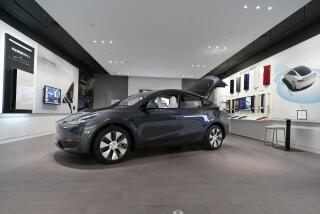Getting a grip on vehicle stability
- Share via
The auto industry is working full speed on advanced systems to improve the stability of vehicles, an important safety advance in light of the growing numbers of highway deaths linked to rollover accidents involving sport utility vehicles and light trucks.
The new systems use both hydraulic and electronic devices that will help keep vehicles under control during emergency maneuvering, which frequently causes crashes and rollovers. Only 6% of all vehicles sold in the U.S. have an enhanced electronic stability system, but the aim is to create enough consumer demand so that systems become standard, industry officials say.
Studies in Germany, Sweden and Japan released this year show that electronic stability controls can reduce overall crashes by 15% and rollover crashes by 25%. Earlier this year, federal regulators identified rollover crashes involving SUVs as the fastest-growing segment of fatal accidents.
But new technology will do little to help millions of SUVs, which are inherently less stable because of their higher centers of gravity. It is crucial to maintain suspension systems and tires in perfect working order, industry experts say.
Better tires, shock absorbers and struts also can help prevent rollovers. Shocks help reduce the tendency of a vehicle to roll or lean as it enters a tight turn or spins out of control. “As a vehicle turns, the springs compress. What the shock or damper does is reduce the rate of that roll angle,” says Mark Christiaanse, product manager at Tenneco Automotive, the largest U.S. maker of vehicle shock absorbers.
When a shock absorber is worn out a vehicle tends to lean over at a faster rate on turns, increasing the chance of an accident. If the shocks do their job properly -- along with wheels, tires and brakes -- the vehicle will have greater stability.
Safety experts at General Motors and Ford say even the most top-heavy SUV should not roll over on smooth pavement even if it is spinning out of control.
But the dynamics can change quickly if an SUV hits a curb, a pothole or even a large crack in the pavement. Such an impact is called a trip, and as its name implies it can create a force sufficient to literally trip an SUV onto its side.
Many drivers lose control of their vehicle by attempting an emergency maneuver and over-steering. Then the driver tries to compensate by steering in the other direction, which often puts the vehicle into a skid or spin.
SUV owners should consider buying aftermarket shocks that can enhance stability at relatively low cost. Monroe, for example, has an advanced shock system known as Reflex that can be installed on a vehicle for about $200 to $350. The system increases the amount of damping, or resistance, when a car hits a pothole or goes into a spin, but provides a less stiff ride.
Meanwhile, manufacturers are attempting to raise motorist awareness about electronic stability control, a system that uses wheel sensors, steering wheel sensors, gyroscopes and computers to control braking and engine speed to improve stability. The system essentially compensates for driver errors.
“We want to help generate consumer demand so the customer walks into the dealer and says I want this on my car,” says Jim Gill, president of the Electronic Stability Control Coalition, a partnership of the German manufacturers Continental Corp. and Robert Bosch. These electronic stability systems, which can add $500 to $1,600 to the cost of a new vehicle, are available on Mercedes, Toyota, Porsche and Volvo vehicles.
The systems are not as widely available on U.S.-manufactured vehicles. The Ford Explorer does offer the option, but buyers must order a V-8 engine and a tow package to get the system, which is supplied by Continental, Gill says.
Another stability system expected on the market soon is a Tenneco Automotive invention that will use a complex system of hydraulic lines and valves to enhance vehicle stability without the need for sensors and computers, Christiaanse says.
Even with the best advanced technology, however, SUVs with their high center of gravity generally will be less stable than cars with similar equipment. They also pose a serious risk to other drivers in a crash because of their weight and high bumpers -- a problem many critics think should be addressed by federal regulations.
Ralph Vartabedian responds in this column to automotive questions of general interest. Please do not telephone. Write to Your Wheels, Business Section, Los Angeles Times, 202 W. 1st St., Los Angeles, CA 90012. E-mail: ralph.vartabedian@latimes.com.







